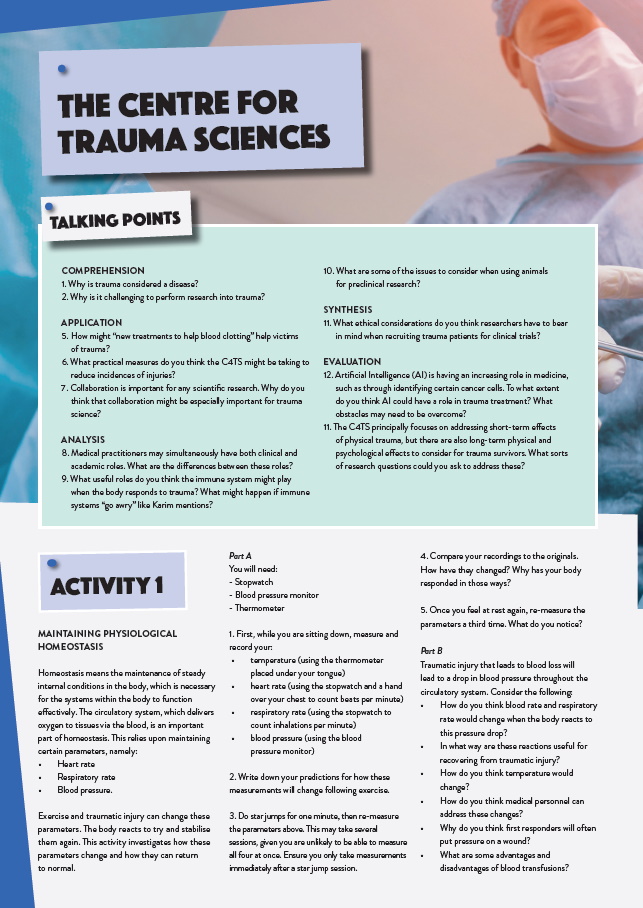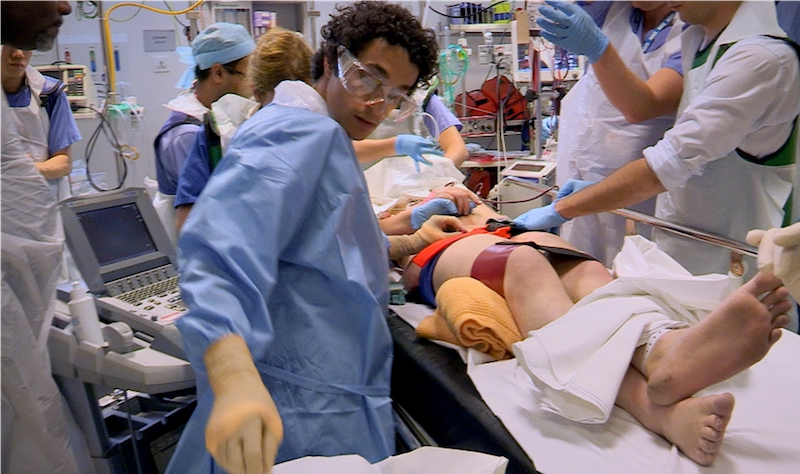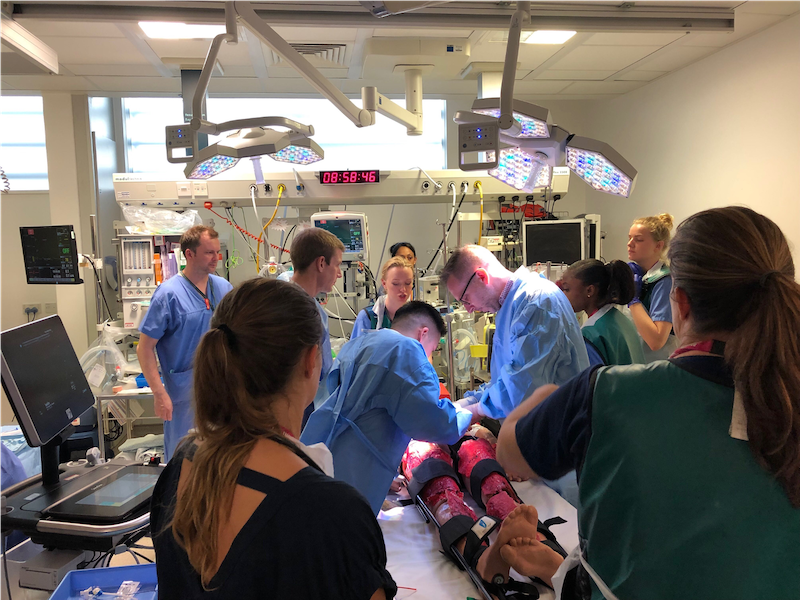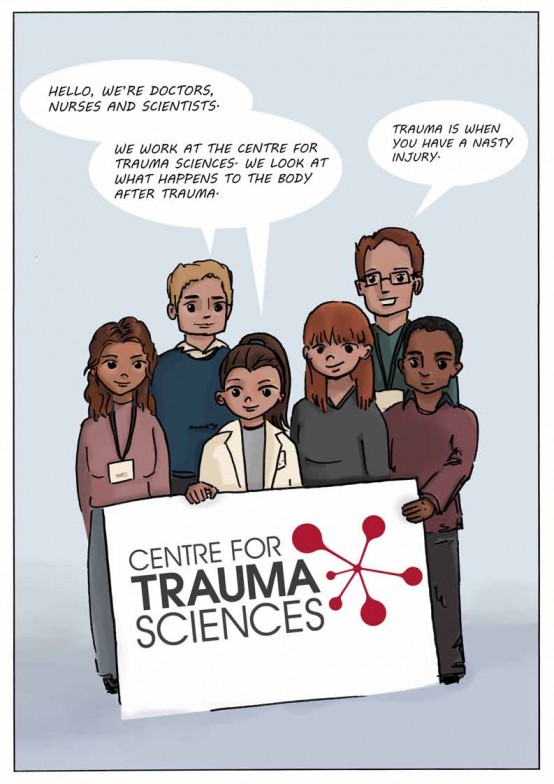Saving lives by investigating how the body reacts to physical trauma
In the UK, traumatic injury is the leading cause of death for people aged under 44. Understanding more about how the body reacts to traumatic injuries, and how best to treat them, is essential for saving lives. Professor Karim Brohi set up the Centre for Trauma Sciences (C4TS) in London, in the UK, to research exactly this, and to help equip medical professionals with the tools needed to treat trauma patients
TALK LIKE A TRAUMA SCIENTIST
BLOOD TRANSFUSION — when a patient receives replacement blood intravenously
CLINICAL TRIAL — research studies, involving patients, that aim to evaluate the effectiveness of medical interventions, such as new drugs or technologies
CLINICIAN — any a doctor who directly treats patients, rather than undertaking lab research
CRYOPRECIPITATE — a frozen blood product made from blood plasma
DISEASE — any disorder of the body, typically having specific symptoms
HAEMORRHAGE — a severe loss of blood through a ruptured blood vessel
RANDOMISED CONTROLLED TRIAL (RCT) — a clinical trial in which patients are randomly assigned to either a control or intervention arm
TRAUMA — in medicine, a physical injury
TRIAGE — in in medicine, the method by which patients are assessed based on the urgency of treatment, in order to prioritise the most urgent cases and direct patients to the most appropriate medical practitioners
TRAUMA FACTS
• Traumatic injury is caused by various forces from outside of the body, which can either be blunt or penetrating (sharp).
• Blunt trauma includes falls, road traffic crashes, crush injuries, assaults (eg., punches and kicks) and burns.
• Penetrating trauma involves shooting, stabbing or falling onto a sharp object (known as impalement).
• Traumatic injury is the leading cause of death for people aged under 44 in the UK.
• Up to 17,000 people in the UK die from traumatic injury every year.
• For every trauma fatality, between three and four patients survive with a serious or permanent disability.
• Many people who experience a physical trauma also experience psychological and emotional difficulties, which can sometimes be long lasting.
Have you ever watched a TV drama, film or ‘fly on the wall’ docuseries where a medical emergency takes place? The urgent wheeling of beds through hospital doors, the concise and urgent communication between medical professionals, the wait to see how the patient fares… We watch these life-or-death scenarios, gripped to our seats, in awe of the professionals dealing with them and willing their hard work to succeed. We can picture such dramatic scenes and imagine paramedics, doctors and nurses referring to trauma and life-changing injuries, but what does trauma mean in medical terms? How does it impact the body? What knowledge, research and expertise are needed to help people survive trauma?
“In medicine, trauma refers to physical injuries to the body and their consequences,” says Professor Karim Brohi, a trauma scientist and surgeon. “It’s classified as a disease because, like any disease, it has its own specific causes, its own biology, and its own treatment and outcomes.” Given that traumatic injuries can vary hugely, it is important that medical professionals know the best way to deal with any trauma case that enters the hospital environment.
Early on in his career, Karim came to realise that the management of trauma patients was flawed. “In the UK, lack of trauma experience and poor organisation of trauma services means that patients are still dying from treatable injuries,” he explains. “This has fuelled my ambition to improve these standards.” Developing best practice requires a strong evidence base to set standards, and this was what Karim saw was lacking.
In response to this realisation, Karim set up the Centre for Trauma Sciences (C4TS) to improve collective understanding of trauma and how to treat it. The C4TS works across two world-leading organisations, Barts Health NHS Trust and Queen Mary University of London, both of which have a deep commitment to trauma care.
WHAT MAKES THE C4TS SPECIAL?
“We are unique in so many ways,” says Karim. “I wanted to enable high-quality trauma research that would attract scientists and clinicians to work in this field, and that would show that high-quality research is not only possible in this difficult environment but can save many lives.” Researching trauma is not easy. Every case is different, and treatment is usually urgent, meaning that it is far more challenging to set up the typical requirements of good research, such as carefully controlled variables, precise measurements and sufficiently large sample sizes.
The C4TS manages to overcome these challenges. “We have developed an embedded research team that works alongside the clinical trauma teams 24 hours a day, seven days a week, to study patients within minutes of their injuries,” says Karim. “We work closely with our patients and clinical colleagues to develop our research programme, and we have a strong commitment to making our research outputs available to everyone.”
AREAS OF FOCUS
Principally, the C4TS deals with the immediate aftermath of injury. “At the moment, we are working on developing new treatments to help blood clotting, supporting the heart after trauma, and understanding how the immune system responds to injury,” explains Karim. “We are also looking at ways to prevent injury, for instance by reducing violence or cycling accidents.” The centre is conscious of the importance of ensuring healthcare is equitable and effective for all in society and is looking into ways to facilitate this.
“Some of our team will be recruiting new patients, some doing follow-up assessments, and some working on their own research projects – in the lab or on computers,” says Karim. “The team also participates in a lot of talks and other educational activities.” A central component of the centre’s work is ensuring that its research findings are taken up in practice and policy, rather than ending their journey in medical journals, so that they bring real, tangible benefits to patients.
SUCCESSES
Thanks to the participation of patients and the ongoing work of researchers, Karim and his team have learned more about how a traumatic injury can affect the blood, particularly in the hours following an injury. The C4TS has now been running for over a decade and has made big strides. “We have discovered a huge amount about how the body responds to critical injury,” says Karim. “Sometimes, the body responds appropriately, but other times systems can go awry.” These discoveries have led to the development of new treatments and management techniques, both in hospital and at the scene of injury. “For instance, our findings have completely changed how we resuscitate patients,” says Karim. “Overall, we have reduced deaths from critical bleeding by over 40% in the last ten years.”
Collaboration will be key to future successes. “Trauma is important and complex, so it takes many researchers and clinicians around the world to make progress,” says Karim. “We support research networks in London, across the UK and internationally.” The team collaborates with trauma units in Europe and the US and conducts clinical trials for products designed to help treat trauma. Karim envisages a future where specialised trauma care is available from the moment of injury to the end of rehabilitation, and research is essential to inform this development. “We want to halve deaths from trauma again in the next ten years,” says Karim. “That’s our vision and our goal.”
Reference
https://doi.org/10.33424/FUTURUM305
Working in the field of trauma involves a life of learning, with endless rewards. For more information about working in the field of trauma, see the C4TS website: www.c4ts.qmul.ac.uk
Educational resources have been developed for a range of trauma related subjects. Access to these resources is available on the C4TS website: www.c4ts.qmul.ac.uk/education-outreach/public-engagement-for-children-billy-and-his-blood-cells-
 PROFESSOR KARIM BROHI
PROFESSOR KARIM BROHI
Head of Trauma Sciences research team, Centre for Trauma Sciences, Barts and the London School of Medicine & Dentistry (SMD), Queen Mary University of London, UK
FIELD OF RESEARCH: Trauma Science
RESEARCH PROJECT: Understanding how the body responds to trauma and how to treat it
FUNDERS: National Institute for Health Research (NIHR), Medical Research Council (MRC), European Union (EU), Barts Charity, Rosetrees Trust
RESEARCH IN ACTION
Working in trauma means working with people with a range of injuries and experiences. Trauma can occur from a fall, an accident or from crime. Regardless of how the trauma occurs, medical professionals are passionate about helping trauma victims regain their independence and heal in the best possible way. From working directly with patients to raising awareness of trauma injuries and trauma sciences with the public, the scope of the research conducted at the Centre for Trauma Sciences is wide and varied. Which aspect of the centre’s work interests you the most?
EMBEDDED RESEARCH
The C4TS’s approach to trauma care is research-led.
“We have developed a 24/7 embedded research team that works alongside the clinical trauma teams to study patients within minutes of their injuries.”
Professor Karim Brohi
CLINICAL TRIALS
Clinical trials – research studies involving patients – allow the C4TS team to trial and evaluate the effectiveness of the medical interventions its researchers are developing.
“I love working in a role that I feel makes a positive difference to individual people. Whether it’s through researching a better healthcare pathway for someone who needs it or trialling a new medical device that may just make a crucial difference for a very poorly trauma patient, I feel like what I do matters, and that’s why I do it.”
Claire Cochran, Clinical Trials Manager
CRYOSTAT-1 was a feasibility study for a multi-centre, randomised controlled trial (RCT) evaluating the effects of early administration of high-dose cryoprecipitate (a source of fibrinogen that enables the blood to clot) in adults suffering major traumatic haemorrhage (severe blood loss).
CRYOSTAT-2 will report on the effect of early cryoprecipitate (within 90 minutes of admission) compared to standard blood transfusion therapy. CROSTAT-2 will begin in 2023.
For more information, visit: www.c4ts.qmul.ac.uk/research-programmes/cryostat
CRASH-2 was a clinical trial that looked at how effective an existing drug (tranexamic acid) was at reducing bleeding in patients following a traumatic injury. Results of the CRASH-2 clinical trial found that giving tranexamic acid within 1 hour of traumatic injury significantly reduced the risk of death from bleeding in trauma patients.
Activation of Coagulation and Inflammation in Trauma (ACIT) is the main pathway C4TS uses to enrol trauma patients in research studies. All trauma patients, young and old, who arrive in participating trauma centres are eligible for enrolment.
This allows clinical data and blood samples to be collected from trauma patients to support multiple studies investigating the body’s response to blood and transfusion therapy. ACIT is designed to investigate how the body’s inflammation and coagulation (clotting) pathways are activated immediately following major trauma, so researchers can find ways to target and treat them if they go wrong.
For more information, visit: www.c4ts.qmul.ac.uk/research-programmes/acit
RESEARCH PROJECTS
There are many research questions being investigated in the field of trauma science. For example, researchers at the C4TS have studied how tissue damage can impact the immune system within minutes to hours after injury – a period known as the hyper-acute window. C4TS’s research suggests that immune responses during this period may determine whether a patient develops organ failure. Understanding these very early immune responses may help identify treatments to prevent organ failure after trauma.
“My main interests include organ failure and the early immune response to major injury. As well as lecturing, I also help lead a randomised control trial which is examining whether a drug called artesunate can reduce organ failure after trauma. Combining a clinical job with academia and family is a big challenge. I am constantly seeking ways to organise my time, maintain balance and remain healthy. I am privileged to work with inspirational colleagues who share my interests and provide thoughtful mentorship and advice. This helps drive my enthusiasm and motivate me during challenging periods.”
Joanna Shepherd, Clinical Lecturer
REHABILITATION & AFTER-CARE
While medical professionals are on the ground seeing patients right after their injury, conducting surgery and providing patient care, researchers are learning new ways to treat patients and improve their chances of rehabilitation and improve their quality of life.
“Having a background in counselling psychology and sociology means that I do not have a traditional medical background. However, my background in the social sciences has provided me with the skills to support patients and their family members with a range of information and guidance if they have been involved in a trauma, through the Aftertrauma.Org website and the AfterTrauma app. If you are not sure which path to take in medicine, just know that there are a range of opportunities for those who have a passion for people and for achieving clinical excellence!’’
Dr Jacqueline Rappoport, Lecturer
PUBLIC SAFETY
The C4TS is committed to ensuring the public is aware of the risks that are associated with trauma in a variety of ways. There are public safety events, educational programmes sponsored throughout the country, and videos and free resources available on the C4TS website. The C4TS team is passionate about providing the public with the resources and tools needed to prevent, understand and recover from trauma.
“In the context of trauma, a death is considered avoidable if the injury is treatable, or if the circumstances could have been prevented. Preventative interventions are known as the ‘public health approach’. A famous example of injury prevention in trauma is the seatbelt. I’m studying the social determinants of violence, trying to understand if there is an intervention that could prevent a violent incident from happening. Working at the front line of trauma care in the UK, I have a privileged opportunity to work with young people and understand what we can do to help.”
Michael Carver, Clinical Research Fellow
MEET KARIM
As a surgeon, I provide care for patients with vascular diseases and traumatic injury. As a scientist, I conduct clinical research and supervise 15 researchers who are investigating different aspects of traumatic disease.
I was interested in pretty much everything while growing up – except learning Latin and piano practice!
I never thought about becoming a scientist. I became a doctor and then a surgeon. Seeing patients dying of traumatic injuries made me want to do better, and to do that I recognised that we needed a better understanding of trauma.
When I realised that management of trauma patients in the UK was poor, I set up www.aftertrauma.org, a non-profit online forum that provides educational materials, expert discussions and online support for trauma surgeons worldwide.
My educational career saw me studying medicine and computer science, before becoming a medical practitioner. I became qualified in both anaesthetics and surgery, an unusual combination but an extremely useful set of skills for trauma patient management. I have worked for the Helicopter Emergency Service in London, a trauma hospital in San Francisco, and as a consultant at the Royal London Hospital.
Perseverance. Following-up. Collaborating. Questioning. All these attributes have helped me succeed.
I’ve found that insurmountable obstacles are rare. Problems usually suggest you need a slightly different path; you need to move faster, or you need to keep going until the obstacle disappears. My tenacity is helped by the fact that, although I persevere, I’ve never had a problem switching off from my work.
My proudest moments are seeing people who work or study at C4TS go on to get great jobs and do great things.
Don’t follow in anyone’s footsteps. Be interested in something – preferably lots of things – and chase those interests, and see where they take you. You can always regroup and try again!
MEET A C4TS TEAM MEMBER – JORDI
DR JORDI LOPEZ TREMOLEDA
Reader, Animal Science and Welfare, and Named Veterinary Surgeon and Welfare Officer
Jordi comes from a veterinary background and a PhD in biomedical sciences, including an extensive breadth of knowledge on preclinical research. His role in the C4TS includes developing experiments to study trauma and treatment techniques in animal models, with the findings going on to inform clinical trials with human patients.
HOW HAS YOUR CAREER PATH LED TO YOU TO THE C4TS?
My career began as a horse veterinarian before progressing into research, initially with horses but then moving to medical research and diagnostic imaging. At the C4TS, I find my veterinary and research expertise are very valuable and can ultimately help improve patient care.
WHAT DO YOUR DO DAY-TO-DAY RESPONSIBILITIES INCLUDE?
I am the designated veterinarian at Queen Mary University of London, which means I’m responsible for the care and welfare of animals used in medical research. At C4TS, I oversee the development and use of experimental models of trauma to help find new treatments.
WHAT ROLE DO ANIMALS PLAY IN TRAUMA RESEARCH?
It’s currently impossible to avoid using animals for medical research. It is a legal requirement in the UK for medicines to be tested on animals before use in humans. Trauma is a very complex disease which affects the whole body. Using animals allows us to study the interconnected ways that the body responds to trauma.
WHAT CHALLENGES DOES YOUR WORK POSE FOR YOU?
Animal welfare is a key priority of my work. We must ensure that animal suffering is minimised by protecting their well-being as much as possible. Using animals in research is strictly regulated to ensure it only takes place when absolutely essential. Animal welfare also directs the quality of research, meaning that high welfare standards can lead to better treatments for human patients. Raising awareness of the importance of animal care in research and supporting a culture of care is very rewarding, as it makes a direct impact on both animals and staff. Minimising harm can be challenging, and critical compromises are necessary. Unfortunately, some research may cause temporary distress in animals, but is invaluable in discovering new treatments.
WHAT HELPS YOU SUCCEED?
It’s important to be a team player. Trauma research is complex so working with colleagues with different areas of expertise is very important. To switch off, I spend time outdoors, swimming or cycling. It’s important to recharge and avoid feeling emotionally disconnected from my caring role.
WHAT HAVE BEEN THE PROUDEST ACHIEVEMENTS IN YOUR CAREER, SO FAR?
Earning my doctorate degree was perhaps my proudest moment. I also find teaching students and engaging with audiences very rewarding. Communicating about science and why animal welfare is important is very empowering!
WHICH THREE WORDS SUM UP A TYPICAL WORKING DAY FOR YOU?
Interactive, empathetic and multidisciplinary.
Don’t be scared of learning new things. Engage with colleagues, be a good team player, promote empathy, and respect others. Diversity is the greatest strength, so take any opportunity to study or work in different places and countries.
EXPLORE CAREERS IN TRAUMA SCIENCE
Karim recommends looking for volunteering opportunities in local trauma units, finding opportunities to speak to paramedics, nurses or doctors, and reading widely.
The team recommends the C4TS website, which includes information about the centre’s outreach and engagement activities activities and their MSc programme.
You should also look for nearby trauma research programmes at universities or hospitals, and express interest in getting involved via email.
Karim says there is a wide variety of pathways into trauma science, given the many different specialties in trauma care. He believes it is most important to be interested in and excited by what you are learning.
Entry requirements for a degree in medicine will typically look for A-levels (or equivalent) in biology, chemistry and mathematics. Many areas of expertise are needed to research trauma and the ever-evolving nature of the field, so you could also explore areas like basic research, physiology, medical interventions, patient care and computational science.
Do you have a question for Karim or Jordi?
Write it in the comments box below and Karim or Jordi will get back to you. (Remember, researchers are very busy people, so you may have to wait a few days.)












